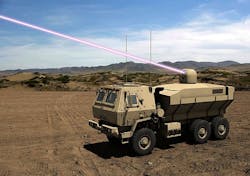Laser weapons demand lots of electrical power, but systems integration also must play a central role
The Military & Aerospace Electronics take:
26 March 2019 -- In addition to power, systems integrators must deal with beam control, targeting, and controls. "we’ve got to get more power — but to me the problem I have today is the integration of that [laser] into my existing combat system," says Rear Adm. Ron Boxall, director of surface warfare on the Navy’s Pentagon staff.
If the laser weapon doesn’t get targeting data from the ship’s radars, it must rely entirely on its own built-in optics. Conversely, the laser’s optics can’t provide targeting data to any other weapon on the ship. Systems integration plays a big role.
Laser weapons can be so precise as sensors and as weapons that they supply and demand much more data, much more quickly, than the radar-guided missiles that the Navy’s Aegis fire control system is built around.
Related: Laser weapons show their stuff in real-world conditions
Related: At long last, laser weapons are nearing deployment
John Keller, chief editor
Military & Aerospace Electronics
Ready to make a purchase? Search the Military & Aerospace Electronics Buyer's Guide for companies, new products, press releases, and videos
